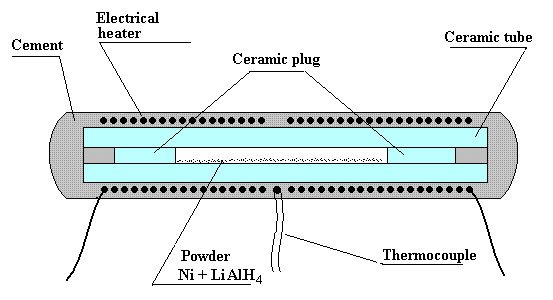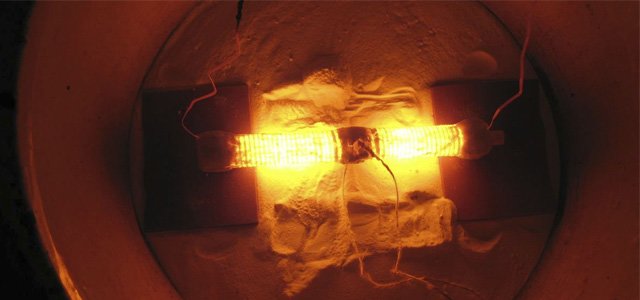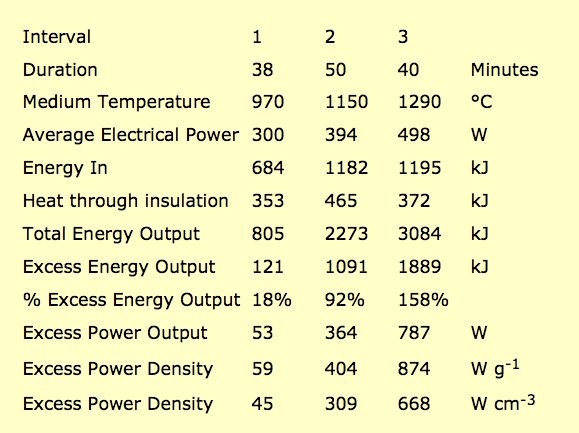This is a re-post of an article written by Michael C.H. McKubre and published in Infinite Energy Magazine issue #119.
The original article can be found here.
by
Michael C.H. McKubre
[Editor’s Note: Alexander Parkhomov’s E-Cat experiment report was issued on December 25, 2014. We have uploaded the original Russian report by Alexander Parkhomov and his English translation.]
The first thing to record is that the document under consideration is an informal, preliminary research note available to me only in English translation of the Russian original. Despite that it reads well. Alexander Parkhomov is a “known” scientist from a highly reputable Institution, Lomonosov Moscow State University, which I have visited on several occasions. He has published work with friends of mine including Yuri Bazhutov (Chairman of ICCF13 and member of the IAC) and Peter Sturrock (Stanford University). These are both very capable senior scientists so that when this research is prepared for formal publication I am sure we can anticipate a complete and solid report.
In the meantime I will comment briefly on what is presented. Because of the community interest in the topic and the apparently clear and elegant nature of the experiment, Parkhomov’s preliminary report has already received an astonishing amount of discussion on the CMNS news group. What is stated in this preliminary report is encouraging, potentially even interesting, but one is struck by material information that is not made available in this report. Much, most or all of this added detail apparently is available to the author so one must await further elucidation from Parkhomov or a serious engineering effort at replication before final conclusions can be arrived at.
Although clearly motivated by the Rossi “Lugano” experiment it is not correct to call either a replication of the other or of any before. These are new experiments, with new characteristics, and some common features. As shown below the reactor active core consists of nickel powder intermixed with a hydrogen (lithium and aluminum) source, LiAlH4, enclosed in an alumina tube and confined with bonded ceramic plugs. This core is surrounded by a helically wound, coaxial electrical heater extended in length to provide closely uniform heating. The whole is potted in ceramic cement to incorporate a single sense thermocouple.

To this extent this configuration mirrors the Rossi reactor recently reported from Lugano although we do not know the similarity or differences between the Ni samples used in each.[1] Since LiAlH4 decomposes to liquid and H2 gas at the temperature of operation its source and nature of are presumed not to make much difference although the impurity content (unstated) may. Also different is the nature of the electrical input used for heating. For Parkhomov this is unspecified. The Rossi effort at Lugano employed 3-phase (50 Hz.) power for the calorimetric input and thermal stimulus but also includes an unknown amount of power in unstated form as a trigger. No such trigger apparently was used by Parkhomov.
The two experiments diverge radically in their chosen means of calorimetry. Parkhomov states that the “Rossi reactor technique based on thermovision camera observation is too complex,” with which I tend to agree. The chosen mean of calorimetry on the new report is to employ the latent heat of vaporization of water — the well known amount of heat required to boil water to steam, in this case at ambient pressure. The heater/reactor combination shown above was enclosed with partial insulation inside a rectangular metal box that was contacted on 5 of 6 surfaces by water.
There are some second order effects that might pertain to this boiling water calorimetry but the method is “tried and true.” It has been employed accurately for well over 100 years and in a slightly different form (boiling liquid nitrogen) was the method selected in recent SRI calorimetry.[2] With simple precautions such a calorimeter should be accurate within a few percent over a wide range of powers and reactor temperatures. One must be concerned to interrogate the heat that leaves the calorimeter by means other than as steam escaping at ambient pressure, that water does not leave the vessel in the liquid phase as splattered droplets or mist (fog), and to accurately measure the water mass loss (or its rate to determine output power). Obviously one also needs to accurately and completely measure the electrical input power.
Although this last issue has been recently (and anciently) raised it is very rarely a problem. Measurement of current, voltage and time (power and energy) are some of the measurements most easily and commonly made. Parkhomov does not supply details of the electrical power or its measurement and he is very much encouraged to do this in his formal reporting. I have no reason, however, to doubt the input power statements. Splatter and mist are issues of observation and calibration and heat leaks are a matter of calibration. Much detail is missing here. Full information about the calibration(s) must be provided in any formal report and full resolution of the question “what do the data tell us?” awaits this detail.
In the meantime what can we learn? Parkhomov states without showing that data that: “The power supplied to the heater stepwise varied from 25 to 500 watts.” The thermocouple in the reactor reached 1000°C approximately 5 hours after initial heating. It would be very nice to have these early-time data together with the data for calibration with which to compare; the greatest weakness of this report is the paucity of data. We are forced basically to rely on three data pairs that I have re-tabulated below from the Parkhomov report with some calculated numbers. Three time intervals are reported of varying duration (Row 2) in which the cell reported an average temperature resulting from the stated average electrical input power, and accumulated the stated Energy In. Parkhomov states from his calibration (not shown) that the heat leak from the system to the ambient is 155 W with the boiler at 100°C. From this heat leak rate we can calculate the energy that leaves in each interval through the insulation and from the mass of water lost we can calculate the heat that leaves as steam by using the known latent heat of vaporization of water (40.657 kJ /Mole or 2258.7 kJ / kg of H2O). The sum of these is the Total Energy Output, the second half of our three data pairs.
These tabulated data (although few) exhibit an impressive set of characteristics:
- Excess energies of ~120 to ~1900 kJ in 40-50 minutes.
- Energy output greater than heat leak rate for the two higher input powers so that even if this loss approaches zero there is still calculated excess energy.
- Percentage excess energies (and therefore average power) of ~20-160% with increasing input power and temperature.
- Average excess powers of ~50 to nearly 800 W with a very small “fuel” load (0.9g of Ni).
- Excess power densities of ~60 to nearly 900 W g-1 of Ni, well within “useful” regimes and consistent with previous CMNS results.
- Excess power densities for the small reaction volume (~1 cm3) of ~50 to nearly 800 W cm-3.
All of these characteristics are exceptionally favorable. In the “plus column” we can also add that the experiment should be very easy to reproduce and we will hopefully soon have well-engineered replication attempts and conceivably confirmations. The experiment also does not appear to need stimulation[3] other than heat, hydrogen and possibly lithium or the need for solid-nickel/molten-metal interaction. So what are the worries? A very large amount has been said about this experiment in part because of the spectacular character of the tabulated data. Over and above the obvious need for calibration data and complete run-time data (ideally in the form of numbers not just plots) not everybody is happy. Why not?
Although others may have further points to add I would summarize three major concerns expressed[4] with the material that has been presented (rather than what was not):
The unexpected behavior of the Temperature at high power. When excess power (of apparently considerable power density) is being created one would expect to see the temperature of the source to be increasingly elevated. The observed trend is not in the “right” direction.
A plot of the data tabulated by Parkhomov for Reactor Temperature vs. Input Power is a stunningly good fit to a parabola. Because of limits of accuracy and precision experimentalists normally expect such close fits to be the result of calculation, not measurement. The goodness of fit may be explicable by the author or just be a fascinating coincidence.
A temperature arrest of approximately 8 minutes occurred at the end of the experiment after the rapid power and temperature drop following heater failure. This “Heat after Death” episode was preceded by a similar period of apparent temperature fluctuation. Either episode or both might be important signals of the underlying heat generation process or may signal sensor failure. It is difficult to resolve this ambiguity without redundant temperature measurement.
In the absence of relevant calibration data at least, and (better) a finite element model of the complex heat flow from the system as well, one can use only experience and intuition to predict what the reactor thermocouple sensor should register as a consequence of changing input power. The input power to the helical heater has a known (distributed) location. The excess power, however, while (presumably) volumetrically constrained has no defined or necessarily stationary position within the fuel volume. Even the first step of heat flow is therefore complex but an argument has been made qualitatively that, all else being equal, if you add a heat source the temperature should go up. Does it?
Let’s look first at a plot of percent excess power (left vertical axis) and temperature (right vertical axis, °C) as a function of input power (W). Three different colored curves are plotted for three different postulated values of the conductive heat leak from the calorimeter: red (155 W) the heat leak power calibrated by Parkhomov and assumed to be constant throughout the active run; blue (102 W) the value that makes the excess power for the first data point zero, as a conservative internal calibration; green (0 W) no heat leak, the most conservative estimate possible for this term. There is nothing at all surprising about this set of curves, and something quite encouraging. The observed excess power cannot be explained by an error in the conductive heat leak or any changing value of that parameter. The temperature of the reactor rises monotonically and smoothly with increasing excess and total power.

Now let’s look at the same data plotted against the measured reactor temperature below. Here we see some indication of the first concern enumerated above. Although slight, the curvature of this family of curves is up suggesting that as the excess (and total) power measured calorimetrically by the released steam increases, so also does the rate of heat (or temperature) loss from the thermocouple sensor. Although this might indicate a measurement problem (unknowable without calibration data) note that the deviation cause by this curvature is well within the variation bounded by the assumed heat leak to the ambient and might easily be caused by a relatively small change in this calibrated “constant.”
At least two unincluded heat loss term are known that must cause the heat leak constant to change in the direction to cause upward curvature: radiant heat loss from the reactor to the enclosing metal box at higher temperature; increased convective transport from the enclosing metal box to the inner wall of the “steamer” at higher rates of steam bubble evolution. I do not know whether the shape of the curve is a problem or is not. The point that I would like to re-reinforce is that we can only answer such questions definitively and thus gain confidence in the data and therefore knowledge if we have direct access to calibration data in the relevant temperature regime. I would also like to see a good thermal model as the reactor/calorimeter system is nowhere near as simple as it seems having several parallel and series heat transport paths. I realize that such model would be labor intensive and/or expensive to develop so lets start with the calibration. How does the system behave with no possibility of excess power?

As a comment in conclusion, there are gaps and unexplained effects in the data set, notably in the missing calibration data, and the foreground data record is slight. Nevertheless the experiment is clearly specified, easily performed, elegant and sufficiently accurate (with relevant calibration). I would recommend that the experiment be attempted by anyone curious and with the facilities to do so safely, exactly as described. Anything else or more runs the risk of teaching us nothing. I await further word from Parkhomov and reports from further replication teams.
Footnotes:
[1] Parkhomov has stated that the NI used to charge his reactor had an initial grain size of ~10µ and specific area ~1000 cm2/g.
[2] SRI DTRA report and ICCF17 proceedings.
[3] Note that the lack of need for stimulation is very good for demonstration but undesirable for control and thus technology.
[4] The first two points were elaborated initially by Ed Storms, who may make them more strongly than I do here.
About the Author: Dr. Michael McKubre is Director of the Energy Research Center of the Materials Research Laboratory at SRI International. He received B.Sc., M.Sc. and Ph.D. in chemistry and physics at Victoria University (Wellington, New Zealand). He was a Postdoctoral Research Fellow at Southampton University, England. Dr. McKubre joined SRI as an electrochemist in 1978. He is an internationally recognized expert in the study of electrochemical kinetics and was one of the original pioneers in the use of ac impedance methods for the evaluation of electrode kinetic processes. Dr. McKubre has been studying various aspects of hydrogen and deuterium in metals since he joined SRI in 1978, the last 25 years with a close focus on heat measurements. He was recognized by Wired magazine as one of the 25 most innovative people in the world. Dr. McKubre has conducted research in CMNS since 1989.
***********************************END RE-POST
Related Links
Russian scientist replicates Hot Cat test: “produces more energy than it consumes”




I wonder if it would work with aluminum hydride, AlH3 instead of lithium aluminum, LiAlH4. I’d just like to see if lithium is needed for the nuclear reactions to take place. http://en.wikipedia.org/wiki/Aluminium_hydride
I have written a report examining the Parkhomov thermometry and implications. It’s at https://en.wikiversity.org/wiki/Cold_fusion/Nickel-hydrogen_system/Parkhomov (i.e., in Wikiversity, and it is open to public editing at this point, and there can be free comment on the attached Talk page.
Summary: The Parkhomov thermometry shows no apparent room for significant XP at the level claimed. This leads to a hypothesis of error in the phase change calorimetry. If Parkhomov recorded the temperature data from his evaporative calorimetry calibration, if done as stated — by using a reactor without fuel, otherwise the same — the issues could possibly be addressed.
There is a plot of reactor temperature vs. power input. It shows the curvature McKubre refers to at the higher input powers. At lower input power, the temperature varies linearly with input power. The reactor temperature behaves as expected for electrical heating without extra heat.
I will investigate aluminum hydride and report at http://ni.comli.com with particulars.
That will be interesting. AlH3 starts decomposing at 105 C with a melting point of 150 C. LiAlH4’s MP is 150 C (with decomposition).